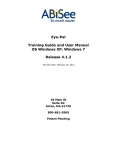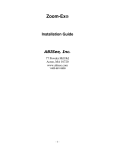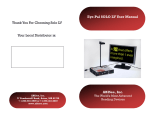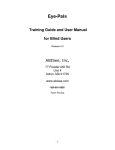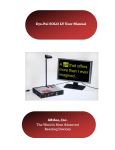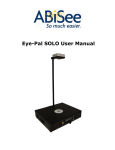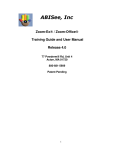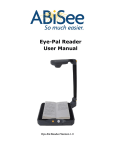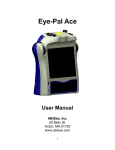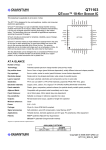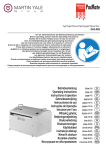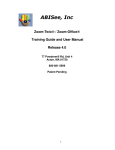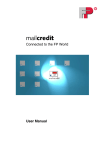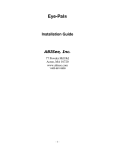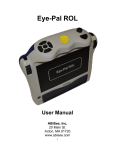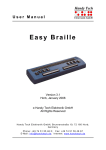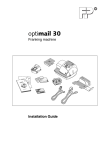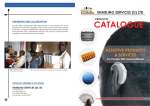Download Eye-Pal®
Transcript
Eye-Pal Training Guide and User Manual for Blind Users Release 1.2 ABISee, Inc. 77 Powdermill Rd, Acton, MA 01720 www.abisee.com 800-681-5909 Patent Pending -1- TABLE OF CONTENTS: What is Eye-Pal? 4 Getting started using Eye-Pal 4 Setting up Eye-Pal 4 Placing a document under the camera 5 Having Eye-Pal talk to you 5 Using Eye-Pal to Convert Printed Text to Speech 6 Start Reading from the Beginning of the Page 6 Page description 6 Moving To the Next or Previous Word, Sentence, or Section 7 Reading through columns and tables 7 Eye-Pal’s Speech Output Options 8 Changing the Voice Parameters 8 Using Eye-Pal to Convert Printed Text to Braille Display 8 Customization Options while using Braille Display 9 Braille Display Keys Definition 9 Document Management Operations 10 To save a document as an image 10 To save a document as text 11 To read a previously saved document 12 What is a Book? 13 Why Do I Need a Book? 13 How to Create and Manage a Book 14 Creating a New Book 14 Choose how to scan and save a Book 15 Adding pages to the new book 16 Useful Tips on Saving a Book 17 Reading a Saved Book 18 Adding Pages to an Existing Book 20 Deleting a Page in a Book 21 Deleting a Book 21 Closing a Book 22 Saving a Book as Text 22 -2- Copying a Book 23 Useful Tips: 23 Reading by word: 24 Reading by character: 24 Reading by sentence: 24 Reading by section: 24 Keypad keystrokes for reading functions. 25 Reading by word: 25 Reading by character. 25 Reading by sentence. 25 Reading by section. 25 EyePal Book Keyboard Command Keys 26 EyePal Book Menu Accelerator Keys. 26 NOTES: 27 NOTES (cont): 28 ABISee Contact and Customer Service Information 29 -3- What is Eye-Pal? Eye-Pal is an electronic scanner-reader that aids blind computer users to read printed material. Eye-Pal connects to your PC or laptop through a USB 2.0 port. There is no need for extra batteries or power packs. Eye-Pal is both a portable camera that scans and software that runs on your computer. Since it folds easily and weighs about 1 pound, it fits in your laptop bag and is easy to carry. Eye-Pal can be used to listen to text-to-speech voice of your choice. It has the ability to read books, magazines, newspapers, documents, medicine bottle labels, etc. It also allows you to read the text on a Braille display of your choice. Eye-Pal reads text documents in many languages aloud using sophisticated, natural language speech synthesizers. No additional software required. Eye-Pal allows the user to create an electronic book without destroying the actual book. For instructions on how to install Eye-Pal software please insert you Eye-Pal CD, if Eye-Pal Setup starts cancel it. Double click on My Computer and right click on the Eye-Pal CD and go down to “open”. Double click on the “PDF” folder and open the Eye-Pal installation file. Getting started using Eye-Pal Setting up Eye-Pal Before setting up your Eye-Pal please MAKE SURE THE SOFTWARE IS INSTALLED FIRST!! Eye-Pal is a portable device that folds to take minimum space in your laptop bag. Unfold Eye-Pal in the following order: 1. Move the camera (housed in the square plastic box) until it locks against the stand (you will hear the click). 2. Unfold the 2 legs until they click. These are horizontal legs that should stay on your desk. 3. To make Eye-Pal even more stable lock each leg manually by rotating the levers located on each of the two legs. -4- Plug the USB connector into the USB port of your PC or laptop; since Eye-Pal runs off your computer’s power, there is no separate power supply or extra battery packs. Placing a document under the camera Once you have plugged Eye-Pal into your computer, place a document under the camera. Eye-Pal has two horizontal legs: the longer leg is 11 and a half inches long, while the shorter leg is 8 inches long. These two legs create a corner guide to assist the user in properly aligning documents to be scanned. Eye-Pal captures and saves the whole 11 and a half inches by 8 inch page. When you are placing your document under the camera try to make it as flat as possible and align it with the legs. If the document is small place a white piece of paper under the camera and place document or book on the top. Orientation of the document doesn’t matter. After you have placed a document under the camera, start the Eye-Pal application. You will hear the computer say “camera started”. This lets you know that the application is running and that Eye-Pal is “on” and ready to scan or read your book. Press the E key to start reading! Now that you have learned how to read a document lets learn the different features of Speech. Having Eye-Pal talk to you You can customize Eye-Pal software in many different ways. When you start Eye-Pal for the first time it will work according to the default settings. There are customizable features that can be changed to your liking. One of these customizable features is Speech Output. By default Eye-Pal will read menus, dialogs, etc. It will also tell you when the camera is ON or OFF, if your document is placed as portrait or landscape, etc. If you do not want Eye-Pal to talk to you, and you would rather have a program like JAWS assist you go to Applications and down to Settings. Under the ‘Speech output’ uncheck Status (Eye-Pal will not inform you about the camera) and/or uncheck ‘Menus and dialogs’ (it will not read menus and -5- dialogs). Click OK. There is one more option that can be used on all toolbars, message boxes, etc: Speech output for the current control – press shift. NOTE: Our application speaks menu bars and dialogs just like the program JAWS, so there is really no need to run JAWS while using Eye-Pal. Using Eye-Pal to Convert Printed Text to Speech Start Reading from the Beginning of the Page To start reading from the beginning of the page place a document under the camera and press the E key. You will hear the voice in a few seconds. To pause/stop the voice press the X key. To resume the voice, press the X key again. Page description A page may have text, pictures, graphics, etc. We define sections as page elements or parts of the page that can be visually separated from the rest of the page. For example, if the page is a newspaper, than each column will be a -6- section. If the page has a picture in the middle of the page, then the text above the picture is first section and the text below the picture is the second section. The key combination Shift + E will describe the page layout. It will tell: 1. How many words are on the page. 2. How many sections are on the page. 3. How many columns are on the page. 4. How many titles are on the page. 5. What percentage of the page is text. Moving To the Next or Previous Word, Sentence, or Section Eye-Pal allows the reader to move around the page, whether its by word, sentence or section. There are a few ways to move around the document page: To move to the next word press Control + Right Arrow; To move to the previous word, press Control + Left Arrow. To move to the next sentence, press the Down Arrow. To move to the previous sentence, press the Up Arrow. To move to the next section, press Control + Down Arrow To move to the previous section, press Control + Up Arrow Refer to the Quick Reference Guide to find the keystrokes on the keypad for the above reading functions. To read a new page, turn the Eye-Pal camera on by pressing the space bar. EyePal will tell you that the camera is on. Place the new page at the Eye-Pal base. To have the entire page read to you press the “E” key. Reading through columns and tables By default Eye-Pal analyzes the text, identifies columns and reads the first column, then the second and so on. If you feel that the information in the columns are connected press Control + T and Eye-Pal will read across the columns. For example, if the first column contains names of products and the second column contain prices of these products it will make sense to read across these two columns. This feature has yet to be perfected. If the page layout is complex there is no way to tell Eye-Pal which way to read the different sections. For example, if the page has 4 columns, and you need to read through 3 left columns first and then read -7- the fourth column from top to bottom you will have to browse through the page more than once. Eye-Pal’s Speech Output Options Changing the Voice Parameters 1. While reading you can change the speed by pressing the shift + Q keys or F9 to make it faster or the shift + Z keys or F8 to make it slower. 2. You can change the voice parameters by going to the Application menu, then to the Settings option, then to the Voice Tab. 3. Press the Tab key to test different voices, select one you like and click on the Apply button. 4. You can also change the speed by using the slide bar on the Speed setting to speed up or slow down the speech rate. Using Eye-Pal to Convert Printed Text to Braille Display Eye-Pal can be used to read printed text on Braille display. At the time of writing this manual you can use 3 Braille displays: Handy Tech, Alva BC-640, and Freedom Scientifics’ PacMate. Please, check our website to find out when more Braille displays will be added. www.ABISee.com From the Braille display you will be able to start and stop the camera, find out the status of camera, and the text processing operation. -8- On all Braille displays left two Braille cells are designated for status. Status codes are: CS – Camera started. PR – Processing. R – Text is ready. LO – Camera’s LED on. LF – Camera’s LED off. TN – Text not found. Customization Options while using Braille Display You can change two parameters that define how you use Braille display by going to the Application menu, and down to Settings, then over to the Braille Tab. The first parameter is Two Left Braille Cells are used to display status. The default is that the box is checked. To turn this feature off, uncheck the box. The second parameter is Do Not Break the Words. If this box is not checked than all Braille cells are used while displaying the text, so to read the last word you may need to move to the next 40 characters. If the box is checked, the last word will not be displayed if it does not fit to the line. Braille Display Keys Definition Each Braille display has a different set of buttons and keys. The following section describes which keys are used for Eye-Pal operations on different Braille displays. -9- HandyTech: Right Space: next line. Left Space: Previous line. S – Start camera. E – Stop camera and process image. ALVA BC-640: eTouch key 3 (right upper key) or right thumb key – Next braille line. eTouch key 1 (left upper key) or left thumb key – Previous braille line. Smartpad key 1 (left key with three horizontal lines) – Start camera. Smartpad key 0 (right key with three vertical lines) – Stop camera. Freedom Scientific PacMate: Push left wheel – Start camera. Push right wheel – Stop camera. Scroll either wheel – scroll through the text. Document Management Operations To save a document as an image Place your document under the Eye-Pal device, aligning it with the two legs of the document guide. You can save document with default name as date/time stamp in My Documents\EyePal\Images\Quick using CTRL + SHIFT+S keystroke. A Quick folder will be automatically created when you save your first document by using CTRL + SHIFT+S keystroke. Note: You will not hear anything or see anything done in the windows box to indicate that the quick save has been performed. To locate your quick saved image please go to My Documents\EyePal\Images\Quick folder, and find the image you just recently saved. You can also save an image in any directory and give it any name by going to the Application menu, then down to the Save Image and pressing Enter. - 10 - A Save document dialog box will appear. Type in the name for your document, and click the Save button. Document will be saved in the default directory My Documents\EyePal\Images. You can select another directory to save the document if you like. To save a document as text To save a document as text that is currently under the Eye-Pal camera press E or any other reading command to stop the camera. The camera will be stopped and the document will start to be read. Press X to stop reading. Once reading is stopped you can save the document as text. NOTE: Do not use SPACE BAR to stop camera unless you are able to see a stable image on the screen. To quickly save text with default name as date/time stamp in the default folder My Documents\EyePal\Temp and immediately display the text file on the screen press Control+SHIFT+W. You can also save text in any directory and give it any name by going to the Application menu and down to Save text then press Enter. - 11 - A Save text dialog box will appear. Type in the name for your document, and click the Save button. Document will be saved in the default directory My Documents\EyePal\Texts. Again you can select another directory in which to save the document. When saving a “previously saved” image as text there is no need to stop the camera because it is already stopped. Follow same steps listed above to To read a previously saved document 1. Go to the Application menu and down to Load Document, and press Enter. A Load Document dialog box will appear. - 12 - 2. Select a document and click Open. The document will appear on the screen. 3. Click E to start reading. Note: You do not need Eye-Pal to be plugged in in order to read previously saved documents. What is a Book? A book is an electronic copy of a book that you can create using Eye-Pal. EyePal allows you to scan and save multi-page documents on a computer. It also allows you to view these documents later on any computer where Eye-Pal software is installed. The Eye-Pal device does not need to be plugged in. While reading a Book you can use all the same document browsing that are available for viewing documents with Eye-Pal.You can also listen while the book is read to you page by page.You can save the whole book as text and use any third party software to read the text file. Why Do I Need a Book? You need a book if there is an article or a book that you are likely to read more then once. Use the Eye-Pal device to save it once, and read it conveniently from then on, anywhere you like, by simply opening the saved book. The Eye-Pal software can be used separately from the Eye-Pal device, to read any saved Eye-Pal document. - 13 - How to Create and Manage a Book Have a book or a multi-page document handy for scanning and reading with EyePal. Place your document under the Eye-Pal device. The Book menu has the following sub-menus: 1. Create New Book. 2. Open Book. 3. Close Book. 4. Save Current Book As. 5. Save Current Book As Text. 6. Add Pages. 7. Delete Book. 8. Delete Current Page. Creating a New Book You can scan and save any kind of book using Eye-Pal, whether it is a small paperback book, a large book with pages up to 8.5’x11’, magazines, etc. To create a new book go to the Book menu and down to Create New Book. The Create Book dialog will appear: Type in the book title and the author’s name. You can also enter the Starting page number if you are not starting on page 1. By default the book will be saved in My Documents\EyePal\Books. If you - 14 - want you can click the Browse button and select another directory to save your book. Click the Create button when your ready to start scanning your book. The Add Pages bar will appear. Choose how to scan and save a Book This bar has three sets of controls: a) Information about page numbers: current and next page numbers. Next page: is the number you entered on the previous screen. b) Scanning Options. c) Scanning Mode. To navigate between the sets of controls use the Tab key. First, select one of the three Scanning Options: 1. Scan one page at a time. Use this option to scan a small amount of large pages. 2. Scan only odd or only even pages. Use this option to easily scan a large amount of pages from a large book. Open the Book and place the left or right page under the camera. If a portion of the second page also appears under the camera, Eye-Pal will ignore it. You do not need to move the book until you have scanned all the odd pages. Once you have finished scanning all the odd pages, do the same for even pages: a) Turn the book 180 degrees. Be sure that the even pages are now under the camera. The fact that the pages appear upside-down does not matter. b) Change the Next Page number to the first even page number. By pressing ALT + N and type the desired number. c) Start scanning even pages. When you have finished scanning all the even pages, click the Done button. Eye-Pal will sort and keep all pages in the right order automatically. 3. Scan two pages at once. - 15 - Use this option to scan small books. If you place the open book under the camera and both pages are inside the Eye-Pal legs, you can save both pages at once. While using this option, book orientation is important – always put the book in the landscape format and align the edges of the book with Eye-Pal base. When you scan two pages at once, both pages will be saved with their respective numbers. If Book failed to separate two pages, it will be indicated by error sound and will save both pages as one page. In this case you can delete that page (Read Deleting a Page in a Book section), adjust the book and save the same pages again. Note: The default selection is Scan one page at a time. Second, select the type of scanning mode. You have two choices: 1. Manual Mode: In this mode, you press the A key or click the Add button to scan and save the page. Note: Blind people may find this option difficult to use, and might want to use Auto Mode below. 2. Auto Mode: In this mode you only click the Start Auto Mode button once to start scanning/saving pages. Then simply turn the pages. The Eye-Pal camera has a motion detector that will save each page as soon as the page is motionless. Auto Mode allows you to use both hands to hold the pages in place, since you don’t have to operate a keyboard. Press “Enter” to stop auto mode. Then Tab over to “Done” and press “Enter”. Now you can read your book. The book defaults to the last saved page, so press ALT + N and type the desired page number and press “Enter”. Note: The default selection is Manual. Adding pages to the new book Now you’ve chosen how to scan/save the book and are ready to start adding pages. 1. Manual mode: a) Put the first page you want scanned under the Eye-Pal camera: it should appear on screen. - 16 - b) Click the Add (A) button. Use your hands to keep the book flat. In a second you will hear a shutter sound. The page is now saved, and the Current page field should display 1, while the Next page number should display 2 if you are saving one page at a time. If you are saving two pages at a time, or even (odd) pages it should display 3. c) Place the next page of your document under the camera and click the Add button or press A on the keyboard. d) Save as many pages as you need by repeating the previous step. 2. Auto mode: a) Click the Start Auto Mode Button b) Place the open book under the camera, keep it still using both hands. In a few seconds you will hear the shutter sound –this pages has been scanned and saved. c) Turn the page, keeping it flat and in a few seconds you will hear the same shutter sound. d) Continue scanning until you have all the pages you need. e) When you are done scanning pages, click the Stop Auto Mode button. When you are completely done scanning pages, click on the Done button. Once you have clicked the Done button, the Add Pages book bar will disappear, and the Read Mode book bar will appear. Note: You can add more pages to this book later. Read Adding Pages to an Existing Book section of the manual for more details. The Read Mode book bar allows you to easily read your saved book with convenient navigation buttons. For more information on reading your book with the Read Mode book bar, read the Reading a Saved Book topic below. If you are done with your book, click the Exit button to close the book. Useful Tips on Saving a Book 1. Place a piece of white paper under the camera and place a book on top of the paper. Eye-Pal will not try to scan the background as part of your document. - 17 - 2. The book under the camera should be as flat as possible. If you are saving a thick book with a lot of pages choose the Auto mode and use both hands to flatten the book. 3. When you are saving a book in Auto mode, Eye-Pal will automatically adjust brightness to the light conditions at that time. If you are taking a lot of time saving all of the pages, take a break occasionally– click Stop Auto Mode and then click Start Auto Mode – to allow Eye-Pal to readjust brightness according to the illumination of your room as it may have changed. 4. When you are saving a lot of pages in Auto mode and you notice that you have to wait a little bit longer to hear the shutter sound, it could be due to one of three reasons: a. The Camera detects motion – wind, unstable hands, etc.; b. The Camera missed a motion when you flipped the page; or c. Eye-Pals camera turned off because the conditions have changed – for example, somebody turned the lights in the room on or off. It is OK. You can always restart the camera by pressing the spacebar and clicking the Start Auto Mode button again. 5. You can only save Two pages at once if there is a wide (half an inch) white space between the pages. If two pages are very close to each other Eye-Pal can’t distinguish the separate pages. In that case, hold the book as flat as possible, and use the One page at a time option. 6. When saving just one page at a time with the One page at a time option or the Only odd or even pages option, make sure that the page you do not intend to save is not fully within the camera view . If both pages fully appear on screen, consider saving them by using the Save two pages at once option. If only a portion of the other page appears on screen, EyePal will know to ignore it. Reading a Saved Book In order to browse through the saved pages of your Book: 1. Press ALT + B to go to the Book menu and go down to Open Book - 18 - 2. The Open Book dialog will appear. This dialog will show the books in the default folder My Documents\EyePal\Books. If you want to open a book that was saved in another folder, use the Browse button to select the desired folder. Note: Make sure you select the folder that contains all your books, and not the folder that bears the name of a specific book. In that folder you might find the folder which bears the name of the specific book – do not select it. 3. Select the book you would like to view, and click the Open button. Note: The Open button is disabled if no book is selected; as soon as you click any book in the list, the Open button will become enabled. The Open Book dialog box disappears, and the “Read Mode” book bar appears at the top of the screen; the last page you read of the chosen book is displayed on screen as well. The “Read Mode” book bar has the Previous and Next buttons, along with the Go to page field and Go button to jump to a page out of order. The Read Mode book bar also has the Current Page field, which displays the number of the page currently being viewed. - 19 - Eye-Pal will tell you the current page number. 4. Click the Next button or letter N on the keyboard to go to the next page in your book; or click the Previous or letter P button on the keyboard to go to the previous page; or put in a page number out of sequence, and click the Go button to jump to that page. 5. When you are done browsing the book, click the Exit button. Note: When the cursor is on the “Current Page” or “Go To Page” field and you are moving from page to page using Previous (P) or Next (N) buttons, you will hear N or P instead of the “Next” or “Previous”. To avoid this use TAB to move the cursor. Adding Pages to an Existing Book To add pages to an existing book: 1. Open the book you need to add pages to by going to the Book menu and down to Open Book. 2. Once the Read Mode book bar appears, go to Book menu and go down to Add Pages. 3. The Add Pages book bar will appear, replacing the Read Mode book bar. 4. Place the page you want to scan under the camera, set its page number, and press Add or letter A on the keyboard. You can save two pages at a time or use the odd/even option. Read Creating a New Book section for details. 5. Repeat step 4 as needed. - 20 - 6. When you are finished adding new pages, click the Stop Auto Mode button first and then click the Done button. The Add Pages book bar will disappear, and the Read Mode book bar will appear again. Deleting a Page in a Book To delete a page in a book: 1. Open the book you want to delete a page in by going to the Book menu, and down to Open Book. The Read Mode book bar will appear. 2. Navigate to the page that you want to delete by putting the page number into the Go to page number: field and pressing Go. 3. Go to the Book menu, and down to Delete This Page. 4. You will be asked to confirm your instruction. Click yes. 5. The page will be deleted; the display will automatically move to the next page, or to the previous page if the deleted page was the last page of the document. If it was the only remaining page of the document, the screen will have an image of last page on it. Deleting a Book To delete a book: 1. Go to the Book menu, and down to Delete Book. 2. The Delete Book dialog box will appear. Select the book that you wish to delete and click the Delete button. You cannot delete the open book. 3. You can use the Browse button to select another directory. - 21 - 4. The dialog gets dismissed, and the selected book is deleted. Closing a Book When you are done reading and working with your book, you need to close it. In order to close the book you can click the Exit button or go to the Book menu, and down to Close Book. The book will be closed, and the book bar will disappear. You can now open a different book to read or create a new one. Saving a Book as Text After you have scanned a book you can now convert the whole book to one text file. Go to the Book menu and down to Save Current Book Text. The text file will be created in My Documents\EyePal\Texts and will have the same name and txt extension. Depending on the power of your computer it could take up to 6 seconds to save each page. So, for 200 pages the process may take anywhere from 10 to 20 minutes. Eye-Pal will tell you the number of the page it is currently saving. - 22 - Copying a Book The fastest way to initially save the book is to save it on the hard drive. After you have scanned your book, you can use the Save Current Book As menu item to copy the book onto a CD or a memory key. 1. Go to the Book menu, and down to Save Current Book As. 2. Use the Browse button to select the drive and/or folder where you want to copy the book. 3. Enter the New Name for the book. 4. Click the Save button. It may take a few seconds to save the book. You may view and read the copy you made using Eye-Pal software on any IBM compatible computer. Useful Tips: 1. If you are working with more than one windows application at a time, Eye-Pal window may loose focus. You know that it has lost its focus if you have tried to turn the camera on or off by pressing the space bar and nothing happens. Click the mouse anywhere on the screen to bring focus to the Eye-Pal application. 2. Eye-Pal will inform you when any message box is shown on the screen. You need to press the SHIFT key to hear the text of the message. - 23 - Notebook (Laptop) keystrokes for reading functions. Start/Stop Eye-Pal Camera: Space or (Caps Lock + Dot). Start reading: E or (Caps Lock +Down). Stop/Pause/Resume reading: X or (Caps Lock +End). Reading by word: Next: Control + Right or (Caps Lock + Right). Current: Control + I. Previous: Control + Left or (Caps Lock + Left). Reading by character: Next: Right. Current: I. Previous: Left. Reading by sentence: Next: Down. Current: Control + Caps Lock + I. Previous: Up. Reading by section: Next: Control+Down. Current: Caps Lock + Shift + I. Previous: Control+Up. - 24 - Keypad keystrokes for reading functions. Start/Stop EyePal Camera: Insert + Delete. Start reading: Insert + 2. (It will read to the end of page.) Stop/Pause/Resume reading: Insert + 1. Reading by word: Next: Insert + 6. Current: Insert + 5. Previous: Insert + 4. Reading by character. Next: 6. Current: 5. Previous: 4. Reading by sentence. Next: 2. Current: Control + Insert + 5. Previous: 8. Reading by section. Next: Control + 2. Current: Shift + Insert + 5. Previous: Control + 8. - 25 - Speech output control keystrokes. Increase voice speed: (Shift + Q) or F9. Decrease voice speed: (Shift + Z ) or F8. Hear page description: Shift + E. Hear current control: Shift. Stop speaking current control: Control. EyePal Book Keyboard Command Keys Add page: A (while creating a new book). Next page: N. Previous page: P. EyePal Book Menu Accelerator Keys. ALT + B is an accelerator for Book Sub-Menu. Key B O D L V A G T Function Book Menu, Create new book. Open Book. Delete Book. Close book. Save current book as. Save current book as text. Add pages. Delete this page. - 26 - NOTES: - 27 - NOTES (cont): - 28 - ABISee Contact and Customer Service Information Please feel free to contact us regarding any questions or concerns you may have. ABISee, Inc. 141 Parker Street. Suite 201 Maynard, MA 01754 Phone: 978-201-9302 Toll-free: 800-681-5909 Fax: 253-595-3623 E-mail: [email protected] - 29 -





























